Few birds enjoy as much popularity and recognition worldwide as penguins. These flightless birds live in the Southern Hemisphere, particularly in Antarctica and its surrounding islands. While relatively awkward on land, penguins move with amazing agility and speed through the water. These black and white birds use their webbed feet and wings as flippers, enabling them to swim up to 22 miles per hour. Scientists recognize 18 different penguin species, which come in a variety of shapes and sizes. The little penguin is the smallest penguin in the world. On average, these cute critters measure 13 inches long and sport unique blue and white feathers. On the other hand, the emperor penguin is the largest species of penguin. These majestic birds can reach up to 4.3 feet long, and feature a yellow collar and breast. Despite their distinctive look, there exist several birds that look like penguins.
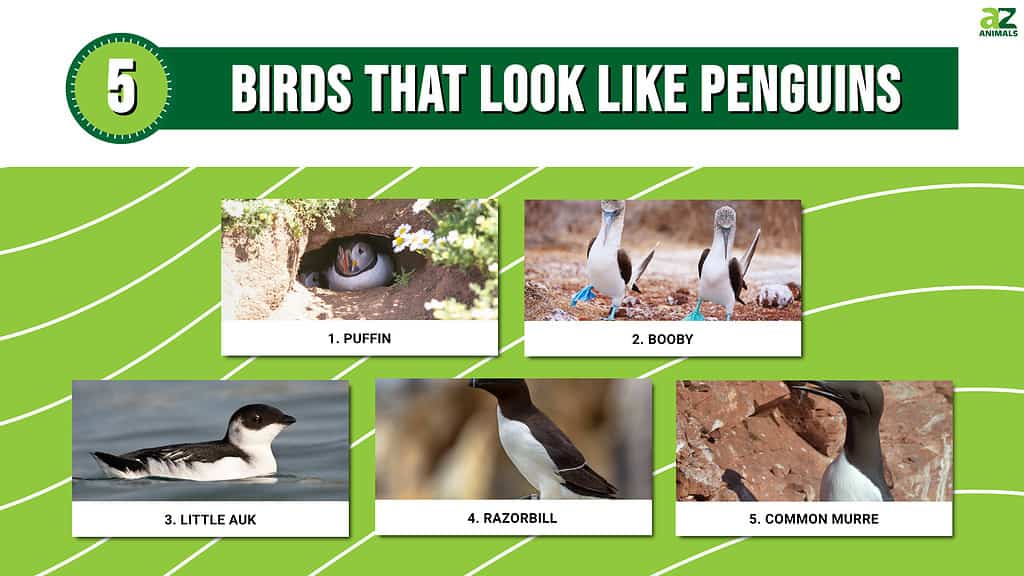
In this article, we’ll discuss 6 different birds that look like penguins. These penguin lookalikes can easily fool a casual observer into thinking they’re penguins. But don’t be fooled, because these birds are anything but penguins. To help you discern the difference, we’ll also spend time explaining how these birds differ from penguins. So, let’s dive in and start learning about penguin-esque birds.
#5: Common Murre
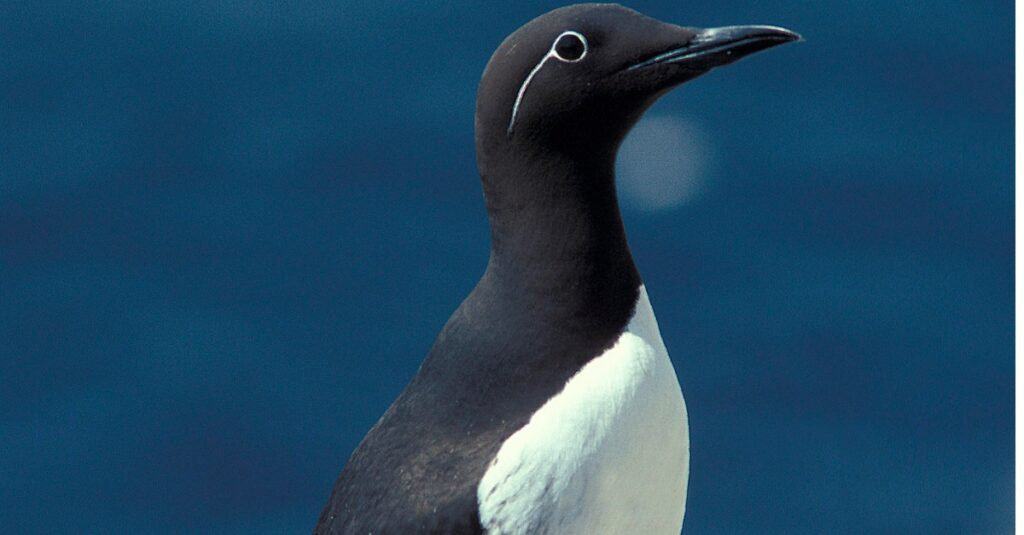
The common murre looks a lot like a small Adélie penguin.
©iStock.com/slowmotiongli
Also known as the common guillemot, the common murre is a large auk in the family Alcidae. They range throughout the Arctic Circle, spending most of their time in the waters of the North Atlantic and North Pacific. Common murres live on a diet of fish, squid, mollusks, and crustaceans, and catch food by diving deep underwater. Capable swimmers can dive to depths of nearly 600 feet below the surface. In order to find food, they may travel up to 60 miles out to sea. During the breeding season, they gather into large colonies numbering in the thousands. Like some species of penguin, they do not create nests but lay their eggs directly on rocky ledges. Their plumage appears white on their bellies and charcoal or black on their backs. On average, they stand around 15 to 18 inches long and weigh from 1.7 to 2.7 pounds.
In appearance, common murres look like penguins, especially small ones such as a young Adélie penguin. That said, you can easily tell apart a common murre and penguin in several ways. For example, unlike penguins, common murres can fly. Although they aren’t particularly agile in the air, they still possess strong wings, not flippers. In addition, they live in completely different parts of the world. All penguins live in the Southern Hemisphere, while common murres only live in the Northern Hemisphere. Lastly, a common murre’s beak is longer and thinner than the beak of most penguin species. While king and emperor penguins sport longer, more tapered beakers, their beaks also feature yellow coloring. Meanwhile, the common murre’s beak is all black.
#4: Razorbill
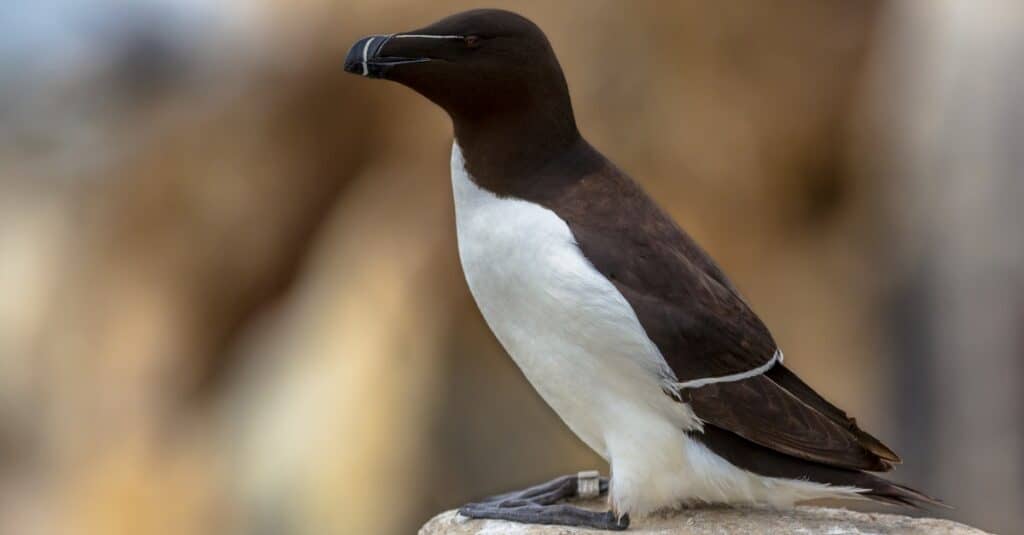
The razorbill could easily be mistaken for a Humboldt penguin.
©iStock.com/CreativeNature_nl
The razorbill, or lesser auk, is another member of the auk family Alcidae. Currently, it is the closest living relative of the recently extinct great auk. Razorbills live in the sub-Arctic waters of the North Atlantic around Greenland, Canada, and Western Europe. The razorbill gets its name from its beak, which contains extremely sharp edges. This adaptation helps the razorbill to grab fish and defend itself against potential predators. Like other seabirds and penguins, it lives off a diet of fish and crustaceans, as well as worms. To catch food, they will dive into the water and swim down nearly 400 feet below the surface. Razorbills mate for life and both males and females will help nest and care for their young. Their belly appears solid white, while their backs look all black. In general, adult razorbills measure 14.5 to 15 inches long and weigh from 1 to 2 pounds.
A razorbill could easily be mistaken for an African or Humboldt penguin. However, look again and you’ll quickly see that a razorbill is just another one of the birds that look like penguins. First of all, unlike penguins, razorbills are strong and agile flyers. Additionally, their feathered wings look very different from the streamlined flippers of a penguin. Another difference has to do with the shape and color of their beak. Unlike most penguins, which feature yellow and orange in their beak, a razorbill’s beak looks only black and white. As for the penguins without yellow in their beak, a razorbill’s beak features a distinctive pattern that sets it apart. Its beak contains a thin, white vertical line near the tip and another that runs along its length.
#3: Little Auk
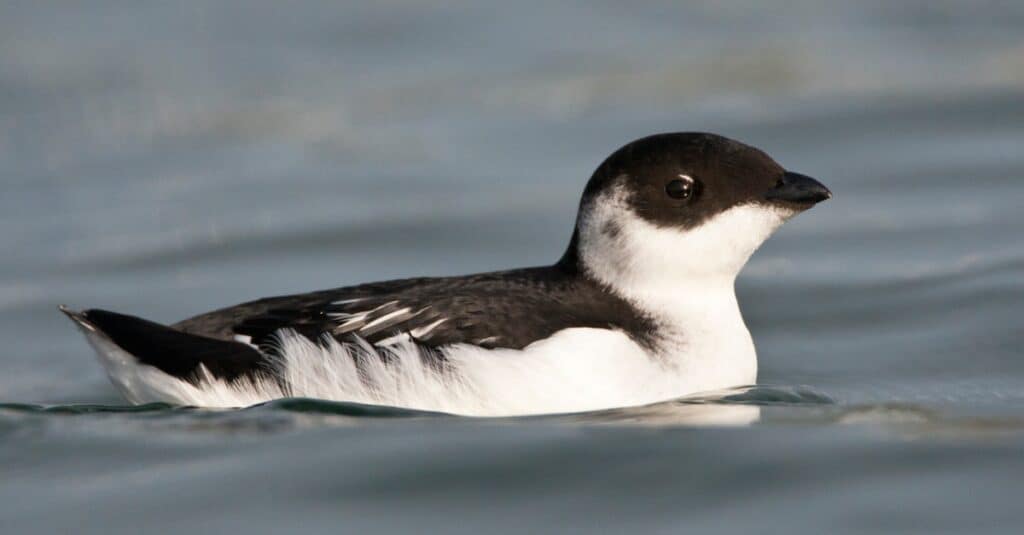
A little auk is substantially smaller than a penguin, although it looks similar.
©iStock.com/AGAMI stock
Also known as the dovekie, the little auk is the sole member in the genus Alle of the Alcidae family. Little auks live in the waters of the North Atlantic from Alaska and Russia to Greenland and Norway. Like other auks, little auks hunt for food by diving underwater. Similar to penguins, they breed in large colonies and lay only a single egg. They lay their eggs on rocky cliffsides and tend to feed close to their nests during the breeding season. Their plumage looks white on their bellies, and black on their head, back, and wings. True to their name, little auks measure quite small, ranging from 7.5 to 8 inches long.
While their color is similar to a penguin’s, a little auk is fairly different from a penguin. First of all, like most birds that look like penguins but aren’t, little auks can fly. In addition, while they do eat fish, their diet primarily consists of tiny crustaceans. Furthermore, little auks measure smaller than even the tiniest penguins. Standing side-by-side, most people could easily distinguish the larger penguin from the smaller little auk. Lastly, little auks feature a very short, curved beak. Compared to a penguin, their beak looks noticeably smaller in relation to the size of their face.
#2: Booby
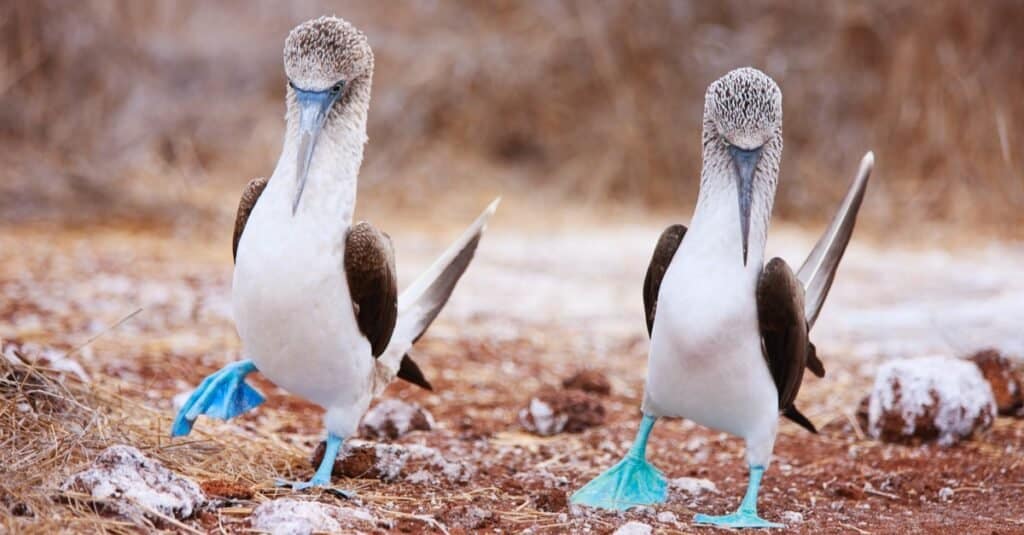
One could be forgiven for mistaking a booby for a penguin, but they actually look quite different.
©BlueOrange Studio/Shutterstock.com
The booby is a seabird in the Sulidae family, which also contains its close relative, the gannet. The booby’s unusual name likely comes from the Spanish slang bobo, or “stupid.” This nickname comes from their habit of landing on ships, only for the crew to catch and eat them. Boobies live in the waters of the South Atlantic and Pacific. Like other seabirds, they hunt for food by diving into the water. They live on a diet of fish, as well as the occasional squid. There exist 6 extant booby species, only two of which look similar to a penguin. Of these 6, the brown booby and blue-footed booby share similarities with a penguin. Both feature a white belly and dark plumage on the backs and wings. On average, boobies measure around 30 inches long and weigh about 3 pounds.
At first glance, one could be forgiven for believing a booby to be a penguin. That said, on closer inspection, the birds look quite different from one another. First of all, a booby’s dark plumage is more brown than black. Second, most boobies feature a solid yellow beak, compared to a penguin’s black or orange beak. The one exception is the blue-footed booby, whose beak is pale blue. In addition, the blue-footed booby’s webbed feet appear bright blue, which is where it gets its name. This stands in stark contrast to penguins, whose feet appear orange, black, or pale pink. Lastly, unlike penguins, who nest on the ground, boobies build their nests in trees.
#1: Puffin
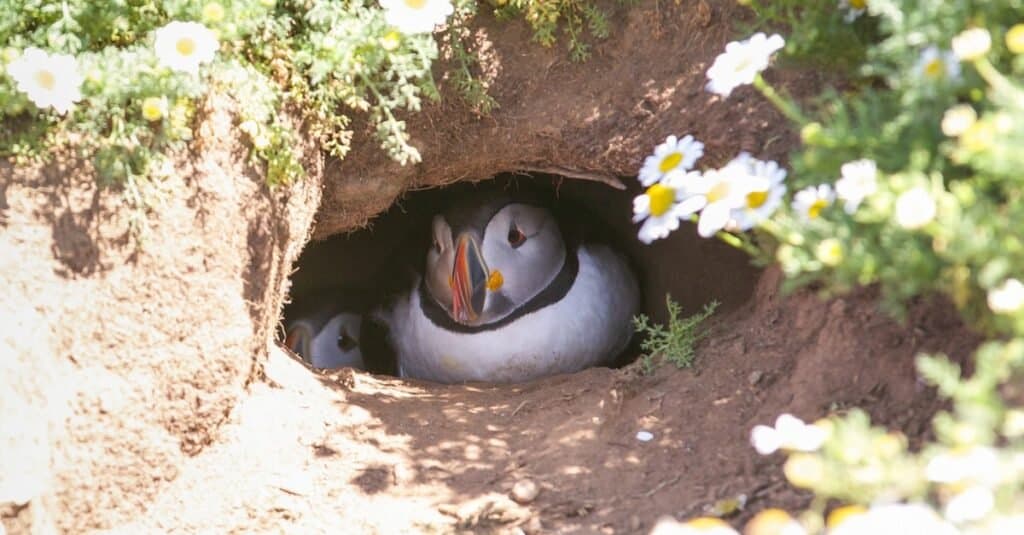
The puffin is often confused for a penguin.
©iStock.com/Henfaes
The puffin ranks first among the birds that look like penguins. In fact, many people mistakenly believe that puffins belong in the penguin family. In reality, puffins belong to the genus Fratercula in the auk family Alcidae. Puffins live in the North Atlantic and the Pacific Ocean. They breed and live in large colonies, and make their nests on rocky cliffs. Like other seabirds, they hunt for food by diving into the water in search of prey. Puffins subsist on a diet of mostly fish and zooplankton. Their plumage includes a white belly and black back, wings, and head. On average, puffins measure around 13 to 15 inches long and weigh between 1 and 1.7 pounds.
Despite the fact that penguins and puffins often get mixed up they differ in many ways. Given their small size, puffins measure smaller than all except the tiniest penguins. In addition, puffins can fly with their short, powerful wings, whereas penguins cannot. Furthermore, while penguins build their nests on the ground, puffins frequently make their nests in burrows. That said, if the ground is too hard, they will make their nests above ground in crevices. One of the most noticeable physical differences between a puffin and a penguin concerns their beaks. While some penguins include color in their beak, a puffin’s beak looks much more colorful. Their beaks contain multiple colors ranging from yellow to red to black and white.
The photo featured at the top of this post is © Giedriius/Shutterstock.com
Thank you for reading! Have some feedback for us? Contact the AZ Animals editorial team.






